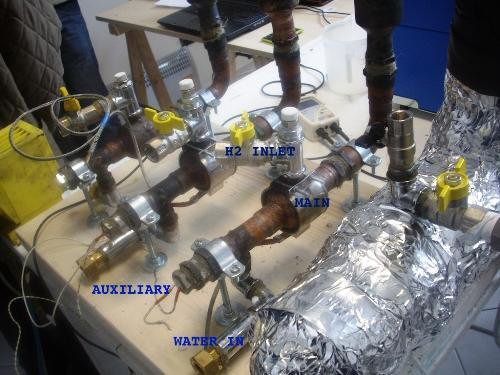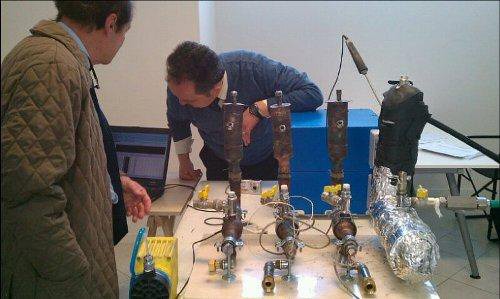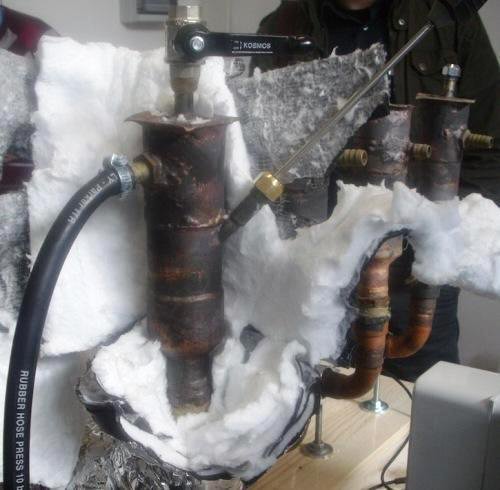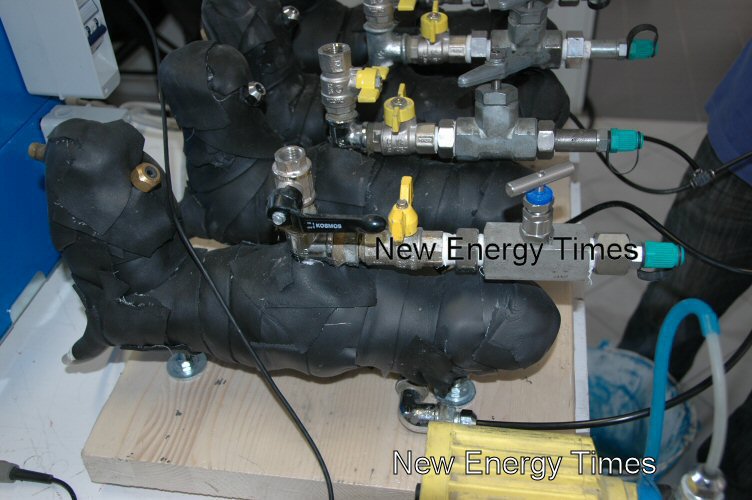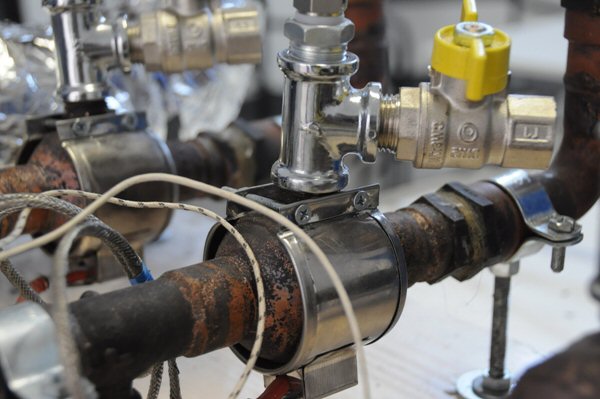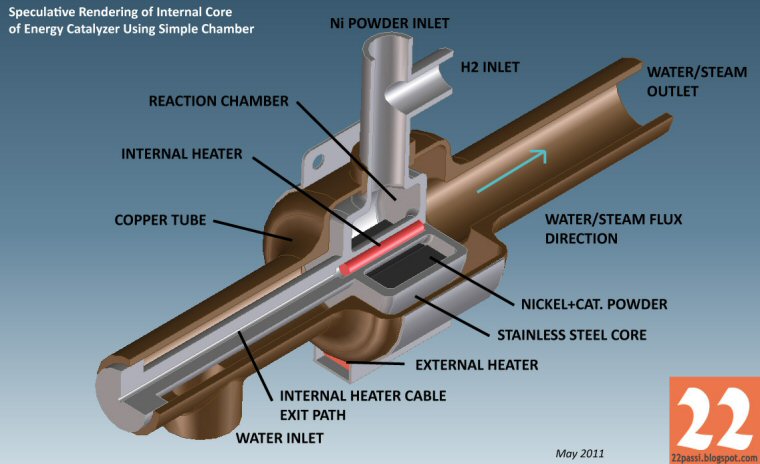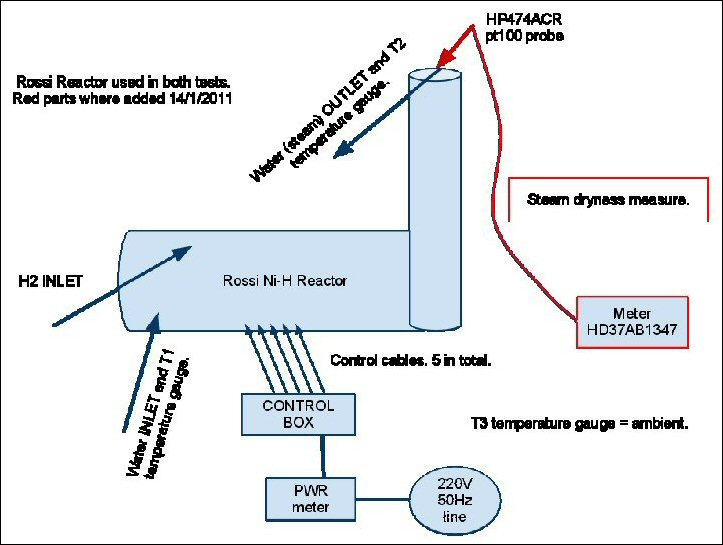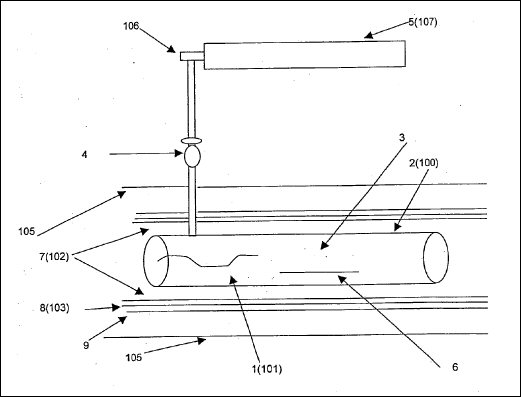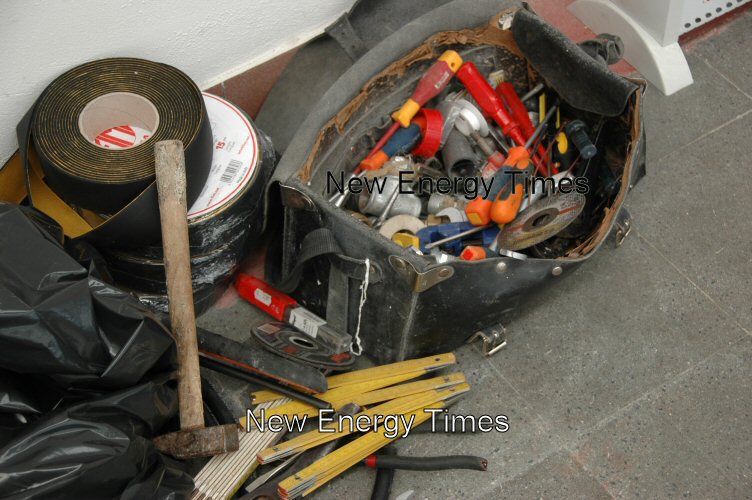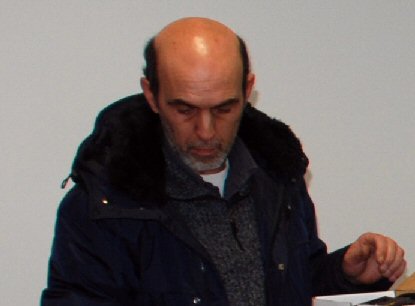|
Energy Balance
The term “energy balance” is related to the term “excess heat” but is broader. Simply, energy balance is a comparison between the total energy going into a system and the total energy coming out of a system. The greater the ratio of the output to the input, the more useful the device. Some devices, such as nuclear fission reactors, which require no input power, are self-heating, and all heat is "excess."
In the case of the Rossi device, the input is primarily in the form of electrical energy that Rossi (normally) continually feeds into the device. Rossi claims that, generally, the input power remains constant. However, in the only two experiments for which the Rossi group has provided data, the input power has not been constant. A mechanical engineer has performed an insightful and detailed analysis on the relationship between the input power and the output temperature of the Jan. 14, 2011, experiment.
Rossi bases his claim of extraordinary positive energy balances on the increase of water temperature and its vaporization into steam. He claims that the temperature rise of the water, as it passes the device core, heats the water up to 100°C, then vaporizes it.
The heating of the water during the liquid phase from, let's say, 20ºC to 100ºC is a simple, straightforward calculation:

Heating Water Calculation
But when the hot water undergoes the phase transition into steam at 100ºC, the following calculation applies:

Vaporizing Water Calculation
In the sample calculation above, we can see that it take takes about 6.7 times more energy to change hot water from the liquid phase to the pure dry-steam phase than it does to warm the water from 20°C to 100°C.
Because vaporizing water takes 6.7 times more energy than heating it from 20°C to 100°C, we must know how much water has turned to vapor. If there are any slugs of liquid water exiting the device and going down the drain in the wall, or any water remaining in the device, then the output energy calculation will be wrong.
Steam Quantity
The first issue Rossi must consider is the quantity of steam; the second is the quality of the steam. Quantitatively, he needs to make sure that no liquid water flows up the vertical pipe and down the hose in a water/steam mixture and down the drain. Qualitatively, he needs to make sure that no small liquid droplets are carried off by the steam and down the hose and down the drain.
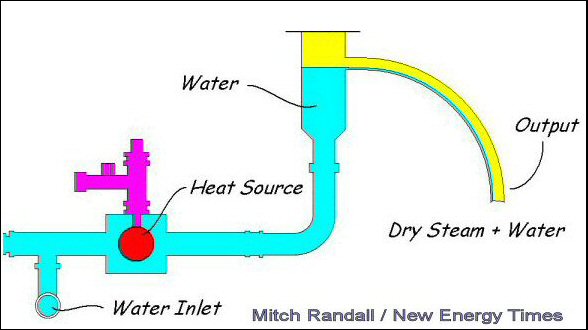
Diagram of Possible Source of Error in Rossi Claims.
(Drawing: Mitch Randall)
In Appendix 1, Mitch Randall, an inventor with 25 years of experience in high technology, explains that the core is submersed in water, the overflow system is being used to regulate the water level and the system requires more water flowing into the system than is turned into steam. Otherwise, the temperature would not hover constantly at about 100C but would go much higher, and the core might overheat. If water flows down the hose, Rossi's vaporization calculations and the bulk of his claims will be invalid.
When liquid water turns into vaporized water (steam), it expands volumetrically 1,600 times. When Rossi showed me his device, he said he was putting 7 liters of water into it per hour. It should have produced 11,200 liters of steam per hour. When 11,200 liters of steam per hour come out the end of the black hose, the speed can be calculated to give a ballpark estimate of the exit velocity.
Because so many crucial non-proprietary details have been omitted by Rossi, Focardi and Levi in their documents, precisely calculating the exit velocity is difficult. However, several researchers have used available information to make their own ballpark estimates to compare with the Rossi group’s ballpark estimate.
Peter Ekström, the deputy head of the Nuclear Physics Division of the Department of Physics at Lund University, calculates that the volume per second of dry steam coming out of Rossi's device should be 3.4 liters per second. Because the inner diameter of the hose appears to be 12 mm* (1.2 cm), this 3.4 l/s would create an exit velocity of 30 meters per second, or 67 mph. He says this is inconsistent with what we see in the video.
LENR researcher and mechanical engineer Domenico Cirillo calculates that the steam exit speed should be 137 mph.
Randall makes a simple calculation and arrives at an exit velocity of 76 mph. (3.4 l/s of steam = 3,400 cm3/s. Hose cross section is about 1 cm2, so velocity of exit steam is 3,400 cm/s = 34 m/s = 76 mph.)
As shown by my video, the exit velocity appears to be not 137 mph or 76 mph but close to 10 mph.
If we have a ballpark idea of the velocity, we can have a ballpark idea of the force. From that amount of steam from that hose, there should be a loud hissing noise; there wasn't.
At the calculated exit velocity, based on Rossi's claims, steam inside the hose has very little time to condense. Calculations in Appendix 3 and Appendix 4 show that the thermal properties of the hose do not permit kilowatts of heat to thermally conduct through the hose.
Therefore, the steam exiting the hose provides multiple pieces of direct evidence against, and no evidence for, Rossi's claim of heat from the vaporization of steam.
When I was in Bologna, Rossi never showed me any steam exiting either from a port on the top of the device (if there was one on that model) or immediately from the port on the side, by removing the hose.
Had Rossi understood the physics of steam engineering, assuming his device worked as claimed, he easily could have shown me — and the public — the intense flow of steam generated from his device. The only reason I can think of that Rossi showed me the steam from the hose is that he did not understand the physics of steam engineering. This point illustrates the importance of valid scientific peer review, to help prevent self-deception.
Had I known more about steam before I went to Bologna, I certainly would have been better prepared to ask more relevant questions. I would have asked to see the claimed 11,200 liters of steam coming out of the top of Rossi's device. But I had learned about the quantitative characteristics of steam, the 1,600 times expansion factor, only the day before. That was a big surprise to me.
The bigger surprise was when I was driving in a car on the highway in Italy, and the person I was with told me to put my hand out the window and feel the pressure of the wind against my hand. He explained that, when I go to look at Rossi's device the next day, I should observe about that amount of force from the hose. Had this person not explained this, I would never have thought to ask Rossi to pull the hose out of the wall to show me the steam, let alone ask him to find a black background to make the steam show up on camera.
On July 5, I asked Essén to look at the steam exiting from the hose in my video of Rossi's experiment. I asked him to compare the exit velocity from the end of that hose to the exit velocity of the steam coming out of the valve on the top of Rossi's device when he observed it on March 29, 2011.
"The steam speed at least seems to be of the same order of magnitude," Essén wrote.
As Essén told me on July 15, he had not known about the 1,600 times expansion factor when he and Kullander went to Bologna. I know of no evidence to suggest that Levi knew about the expansion factor, either. Certainly, if Levi did know, it raises other questions.
Through discussions and references to my video, the significance of the steam exit velocity became known within the LENR community so clearly during the week of July 11 that Edmund Storms, a longtime LENR research, suggested on the Condensed Matter Nuclear Science e-mail list that Rossi knew exactly what he was doing and that he had intentionally deceived me, and therefore the public, when I watched and videotaped his experiment. I have compiled those messages in this document.
Rossi showed me a brief period of a slow, continuous flow of steam leaving the end of the hose. There was no percolating water during that brief time. Essén told me that he saw steam slowly exiting, as well. However, as my video shows, steam is coming out of the hose for brief periods, free of percolating water. Essén told me that he saw this, as well. But as in my video, before Rossi pulled the hose out of the wall, he lifted and held it as if he were draining water out of it.
As I learned in July, Randall back on April 18 asked Essén the key question.
"Was the outlet steam flow rate measured? For example, by condensing steam only and measuring the weight of the resulting water?” Randall wrote. "If not, how did you validate the assumption that all of the input water was converted to steam?"
Essén replied to Randall the next day.
"Since there was no other path for the water than straight through the device in a single hose-pipe-hose track, we concluded that all the water must become steam," Essén wrote. "The steam was checked by observation and appeared to be consistent with the water flow (order-of-magnitude-wise)."
Essén told me that, as a matter of course, as a skeptic, he regularly looks at claims of perpetual motion. He's never found a claim, until Rossi's, that he thought had potential. What Essén meant by "hose-pipe-hose track" is that the water goes in from a hose, through a pipe, and comes out through another hose. Essen assumed that only steam was exiting the device. He apparently didn’t consider that some water could be flowing out of the device undetected, along with the steam.
In their April 3 report, Essén and Kullander wrote that, "at about 10:45, all the water is completely vaporized found by visual checks of the outlet tube and the valve letting out steam from the chimney." On July 15, Essén told me that, on a few occasions during the test they observed, they pulled the hose out of the wall drain for a few seconds and saw steam. Otherwise, the hose was always in the wall. With what we now know and have seen on my video, Essén and Kullander could not have verified that, by a few sporadic visual checks of the hose, all of the water that had originated in the water tank had been vaporized.
I spoke with Essén on July 15 about my concerns about the Rossi experiment.
"I am aware that the question of steam quality is the main point of concern because everything else has been very carefully checked," Essén said.
I asked him whether he had any direct experience with steam or had seen anybody try to use it to make an extraordinary claim before.
"I'm new at steam, unfortunately," Essén said. "I've only studied it in the context of basic thermodynamics. I can't recall anybody who has made this type of claim before."
I asked him whether, when he pulled the hose out of the wall and saw the steam, he thought about the expansion rate.
"No, I must admit, I was thinking that I must check that the water is not draining out," Essén said. "I had this vague feeling that the water inlet flow wasn't that fast, that the steam could be consistent with it, especially after some condensation in the hose. But we should have looked more into that, obviously, but there was not enough time."
I asked Essén about his current perspective.
"I want to wait for more facts,” Essén said. "The facts I know add up to make this interesting and worth pursuing, but I am still very uncertain about this."
In Rossi's case, the observable quantitative characteristics of the steam are inconsistent with his claims. Before I discuss steam quality, I would like to discuss the second-most-important concern about Rossi's claims.
Measuring the Energy Balance
William Collis is the executive secretary of the International Society for Condensed Matter Nuclear Science, a nonprofit organization that helps support and promote LENR researchers. Collis posted a message on the CMNS e-mail list that summarized his concern about measuring the energy balance in the Rossi system.
Francesco Celani was a witness to the January demonstration. Celani is a nuclear physicist and works at the Italian National Institute of Nuclear Physics in Frascati. He is also the vice president of the International Society for Condensed Matter Nuclear Science. Celani was clearly familiar with the Rossi apparatus, and he presented an informative report. I have reviewed the details of his presentation here.
Celani recognized the weakest part of Rossi and Levi's claim: the assumption of complete evaporation of the water. More important, he knew conceptually the correct way that they should have measured the energy balance. In Appendix 19 , a New Energy Times reader shows an effective method to measure power and energy in a steam-producing experiment.
Randall, a New Energy Times contributor, also explained the problem eloquently.
"If you are trying to measure the performance of a ‘black box,’" you should not use a measurement from within the black box," Randall wrote.
Celani's diagrams speak volumes.
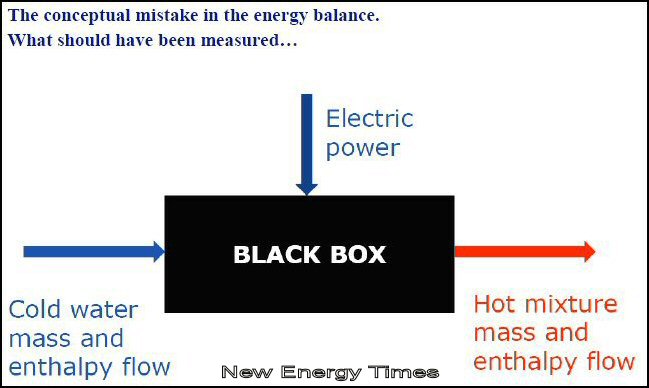
Conceptual Diagram of Correct Way to Measure Energy Balance
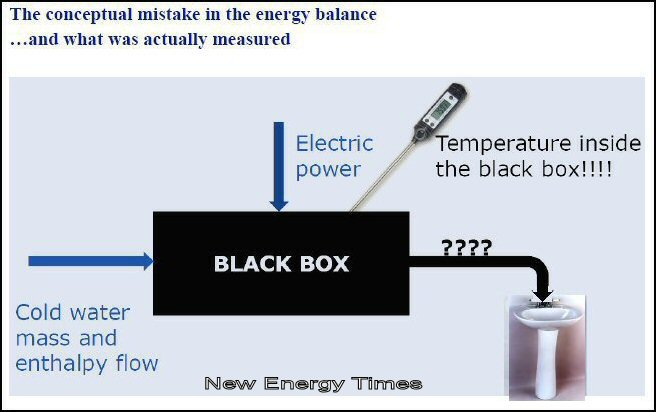
Conceptual Diagram of Incorrect Way to Measure Energy Balance
Steam Quality
The third and less-critical issue that Rossi must consider is the quality of the steam.
Steam quality is sometimes discussed as "wet" or "dry" steam — that is, low-quality or high-quality, respectively. I do not know enough to explain the heat capacity calculations of low- versus high-quality steam. But I have learned the difference between 100% dry steam and humid air. The former is water in the gas phase; the latter is primarily oxygen, nitrogen, water vapor and a few other gases. They are two different gasses with different properties, including capacity to hold heat. I also have learned that devices used to measure the humidity of air are completely different from devices used to measure steam quality. (See Appendices #13, #14 and #23.)
Steam quality relates to the Rossi reactor in the following way. If a certain amount of energy is necessary to heat a certain amount of water from 20°C to the lowest-quality steam, then about 7.75 times as much energy is necessary to heat the same amount of water from 20°C to the highest-quality steam. So the quality of the steam is crucial to computing how much energy was required to generate it.
For example, if the steam in Rossi's experiment had a large number of suspended droplets of liquid (like fog), the amount of output power calculated would be closer to 13% of what Rossi assumed. When steam is at temperatures significantly higher than 100°C, it is almost always high-quality, very dry steam. One interesting phenomenon with very dry steam is that it is colorless and invisible.
Celani was the first person to point out to me the concern about steam quality, both at ICCF-16 and in an e-mail he sent to me.
"The problem is the percentage of water droplets in the steam," Celani wrote. "If I remember correctly, just 1 percent of water [by volume] is enough to reduce the calculated energy by about 600%. This is a critical point of Rossi's measurements, as I have pointed out to him several times and also at ICCF-16."
Appendix 9 presents a scientific analysis by a NASA engineer of steam quality as it relates to Rossi's experiment. The engineer used the 770 watt input power, as stated by Rossi in the video, and computed the quality by mass of the steam that the device would generate if there were no heat from LENR present.
The engineer said that his analysis shows why not only quantity but also quality of the steam is a make-or-break factor for Rossi's claims.
As Levi explains in my interview, there was no attempt to test the steam quality in the Dec. 16, 2010, experiment. However, in December, Levi had concluded that Rossi's claim of kilowatts of excess heat was valid.
An engineering graduate of the University of Bologna who asked not to be identified used a common analogy to explain the problem of trying to measure the quality of steam with a device designed to measure humidity in air.
“It's just like trying to measure your height with a mass balance," he wrote. "They didn't carry out [a steam quality] measurement. They used completely wrong instruments."
Three months ago, but shortly after his visit to Bologna, Essén didn't seem to know about steam quality.
In an April e-mail, I asked him, "Does your analysis take into account the ‘wet steam’ concern? Is this a valid concern, an irrelevant concern or a red herring?"
"I think it is totally irrelevant," Essén wrote. "Boiling water is a fairly straightforward method of estimating power."
I asked Kullander, as well.
"Wet steam is a valid concern." Kullander wrote. "We had measurements done for us showing that 1.4% was non-evaporated. Our visual observations showed that a major fraction of the water disappeared. From thermodynamics, it seems unlikely that more than 10% could be non-evaporated at the measured temperatures.”
How did Kullander visually observe that a major fraction of the water disappeared? As far as I can tell, by looking at the empty water tank, checking the end of the black hose very briefly two or three times (as Essén told me), and assuming that only pure dry steam was flowing out of the black hose and into the drain throughout the experiment.
Rossi's Declaration About Steam Quality Measurement
Despite Rossi and Levi's assertion, in response to my preliminary report, that they knew how to measure steam quality, they didn't, and they hadn't. They didn't use a device that was designed for or capable of measuring steam.
On Jan. 25, 2011, Celani explained in an e-mail to Rossi the problem with the quantitative steam analysis and the qualitative steam analysis. Therefore, by that date, Rossi knew the most crucial problems with his claims.
Rossi replied to Celani the next day.
"We always worked with water, not steam," Rossi wrote, "in the former tests we made all the world around. We also used air. All the data coincide. I believe in the work of Dr. Galantini, who said that the steam was dry, because I am pretty convinced that he is able to establish if a flow of steam is dry or not. In any case, the amount of energy at the output should be obtained also if, at 102 Celsius degrees, we had just water (which is impossible), not steam. I mean, in the worst imaginable scenario, we got our strong surplus in respect to electrochemical production. This is just a calculation by absurd, because the steam was dry, as calculated by Galantini. And we will see it better in the plants that are going to be put in industrial operation."
In an apparent inconsistency, two days after I published my preliminary report, in which I speculated about serious concerns about the Rossi group's steam quality measurements, Rossi said that the steam until that week had not been totally dry.
"The 1 MW plant which we will start up in Greece in October will generate heat," Rossi wrote. "For power, we are not yet ready, but we made a very important step forward in this week, because our reactors now produce a totally dry steam (no more traces of water in the steam), and this is a step forward to couple the turbines. We have 300 reactors in operation now in our factory, and we are making exponential progress day by day."

I was curious about his factory. According to the corporate registration of his company, Leonardo Corp., it is located at 1331 Lincoln Road, Apartment 505, Miami Beach, FL, 33129. It seems odd that Rossi could have a factory with 300 devices on the fifth floor of an apartment building in Miami Beach. Were the 300 devices in boxes? On benches? Drawing power? In various phases of manufacture? Perhaps this isn't really his "current principal place of business" as shown on the corporate registration; perhaps he lied to the Florida government.

Leonardo Corp. (Apt. 505) "Current Principal Place of Business"
(Photo: Google)
On July 17, on Rossi's blog, someone who goes by Mary Yugo posted a question to Rossi about his factory, and this is how he responded:
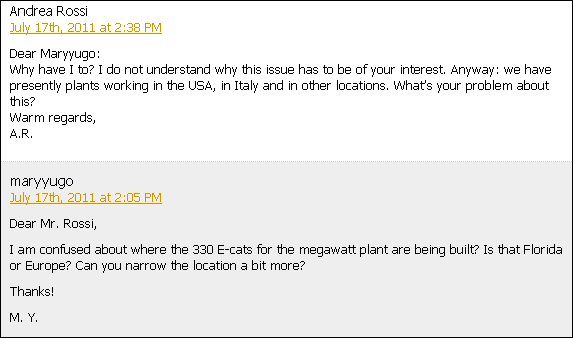
However, on Feb. 2, Rossi was open with Ny Teknik about the location of his factory.
“Here in the factory in Miami," Rossi wrote, "we have 100 reactors like the one we showed in Bologna, almost ready.”
Levi Measures Everything but Output
In a Feb. 2 article in Ny Teknik by Mats Lewan, Levi explained how he monitored Rossi's experiment on Jan. 14, 2011. According to Lewan, Levi "measured the input electrical power with its own instrument, verified that there were no hidden connections, inspected the connected equipment, measured the amount of hydrogen consumed by weighing the bottle (less than 1 gram) and attached it himself to the reactor chamber."
Then Levi stated how much energy output he thought he saw, and he publicly supported Rossi's scientific credibility.
“What has impressed me," Levi wrote, "and what sets this work apart from everything I’ve ever seen, is that we have 10 kW of measured energy output, and this output is completely repeatable.
“I would also like to emphasize that Rossi is behaving as a serious scientist. Anyone who tries to do forgery behaves differently and does not go into a physics department, does not accept that you put up measuring instruments and does not confront scientists.”
Levi makes some strong points. A fully repeatable effect is definitely newsworthy. Rossi's confidence to invite specific members of the University of Bologna Physics Department to check his experiment is interesting.
But in all the checks Levi made, he did not do any direct measurements of the output heat that would tell him the output energy. This oversight is inexplicable.
Sub-Boiling Experiment
So why doesn't Rossi avoid all the uncertainties with steam and increase the flow rate enough so that the water stays well below boiling? I asked Rossi this on May 5.
"Why do you run these tests at such high temperatures so that the water boils? It seems to me that the calorimetry would be much, much simpler if you kept the temperature below boiling, right?" I wrote.
"These modules are configured to boil, because they are the modules of the 1 MW plant we have to deliver," Rossi wrote. "You will see a reactor in regular operation of test-before-delivery. We have not time to do other things. Anyway, the calorimetry is very precise also with the steam."
The only part of Rossi's response that directly addressed my question is Rossi's statement that he doesn't have time to perform a sub-boiling test.
Levi, on the other hand, performed a sub-boiling experiment. But, as he now knows, the data from that 18-hour experiment on Feb.10-11 is next to worthless. His instrumentation and data collection in that experiment left much to be desired. Levi told me on June 14 in the videotaped interview that he intends never to report that data.
But back in February, Levi must have had much more confidence about his data because he provided incredible claims to Mats Lewan as published in the Feb. 23 Ny Teknik story.
“Minimum power was 15 kilowatts, and that’s a conservative value. I calculated it several times. At night, we did a measurement, and the device then worked very stable and produced 20 kilowatts,” Levi said.
As mentioned above in the discussion about the weaknesses of taking measurements of a "black box," from within the "black box," the output measured in this case used a thermometer inserted somewhere inside the Rossi device.
Possible Evidence for Low-Energy Nuclear Reaction
For the reasons I mentioned above, I cannot consider valid any part of the Rossi group's claim of excess heat from the boiling phase or from Levi's sub-boiling experiment. Is there, however, any possible credibility to the sub-boiling phases in the other experiments the group has reported? The Rossi group may have seen some excess heat in the liquid phase in the Jan. 14, 2011, experiment. However, the quality of that data and report, as Levi wrote to me, is “horrible.”
"Yes, the graphs were horrible, because they were taken directly from the raw data of the watt meter without any other processing." Levi wrote. "This was done because the tests were VERY PRELIMINARY and also because the report was intended to be also VERY PRELIMINARY."
And yes, it is possible that Rossi, Focardi and Levi have figured out how to get the same kinds of results that Focardi and Francesco Piantelli had achieved for many years, though perhaps with better repeatability.
First, there is some evidence for anomalous energy, as I discussed in the section "Possible Low Levels of Excess Heat."
There is also one other piece of data that supports some kind of real nuclear reaction. It is the gamma ray spike that Celani saw at the beginning of the Jan. 21, 2011, experiment. I've listened to Celani explain his measurements. I am convinced that he saw a real anomalous gamma signal.
What about the isotopic anomalies that Rossi claimed? There has been so much chatter and confusing information about this. I also asked Kullander to see the data he had found. He told Ny Teknik about the isotopic analysis he performed on sample materials he got from Rossi. Even though Ny Teknik published Kullander's conclusions, Kullander wouldn't show me his data. I asked him why not.
"I would like to draw my own conclusions from the different measurements we have done before I disperse results to anybody," Kullander wrote. "I still need to confirm some isotope numbers."
Before I left for Bologna, I asked Rossi for information about the isotopic anomalies he reported in his March 2010 paper. I asked Rossi whether he could show me the data when I came to Bologna. He agreed. In my meeting with Rossi, he gave me two graphs and stated something about the results that was not clear. However, he did allow me to keep copies of the data, which are in Appendix 21.
Declining Magnitude of Claims
Another concern is the major decline in the magnitude of Rossi's claims. If you look at the data from his March 2010 paper, you see that he is claiming an average of 213 times more heat output than energy input. (See Appendix 30) That's if you make two big assumptions: He vaporized all the water, and the steam was all dry.
If you average the energy results from the experiments performed since December, you get an output/input ratio of 11, one order of magnitude less than the experiments he and Focardi reported in their 2010 self-published paper. On June 17, Rossi wrote on his blog, "We guarantee anyway to our Customers an output of energy 6 times the input." Where might Rossi have obtained this number? It is precisely the ratio of the most recently documented experiments, those audited by Lewan, again, with the two big assumptions.
But what happened to the 213 times energy ratio from the experiments from last year? Rossi has an answer for that. He said when I interviewed him that those were larger devices and they are not safe to demonstrate or to sell.
But there is an apparent inconsistency. According to what Celani said in his ICCF-16 presentation, Rossi said during the Jan. 14 press conference and demonstration that "the same reactor and the same material SURELY worked very well the day before on Jan. 13 with a gain of 100-200" and that that same device worked fine in the Dec. 16, 2010, test. So according to what Rossi said on Jan. 14 in the press conference, this larger device, capable of a 200 times energy output was safe enough to demonstrate before the public. And according to Rossi on June 15, devices of this capacity were not safe enough to demonstrate before the public. Perhaps during those months, he learned about new safety issues. Or perhaps the numbers that Rossi and Focardi quoted in their paper are wrong.
Self-Sustaining Claim
In my video interview with Levi, he said that he had wanted to turn the power off and see the device run in self-sustaining mode. According to Levi, Rossi told him that running the E-Cats without input power is dangerous because they become unstable.
I asked Levi during our video interview to tell me about the best evidence he had seen to give him confidence of a self-sustaining phase. At first, he said that he pulled the plug out of the wall and that there was no power to the system. I showed him his own data, which showed a small amount of power going into the system. I asked him how that was possible if he pulled the plug out of the wall. After some discussion, he told me that he had misspoken; he had not, in fact, pulled the plug out of the wall. Readers can watch the video interview to understand Levi's complete response in context.
Another safety concern is Rossi's plan to guard against intellectual property theft. According to comments he has made on his blog, Rossi thinks he will be able to protect his device from reverse-engineering by building in a mechanism that causes the nuclear device to self-destruct if it is opened.
No Control Experiment for University of Bologna Science Professor
Rossi, Focardi and Levi have not reported any control experiment. I mentioned in Report #2 that Rossi declined my request to show me a control experiment.
Paolo Capiluppi, the head of the Department of Physics at the University of Bologna, wrote to me on June 19 about his concerns.
"We are embarrassed about the declarations of Prof. Focardi, one of the physicists formerly from our department. However, he is NOT a member of the department, being retired, even if professor emeritus," Capiluppi wrote.
Levi, on the other hand, is a member of the department. On June 14, I asked him a question about the tests he performed on Rossi's device.
"So now it's been half a year since those tests,” I said. “Since the December, January and February tests, have you found any major errors or any major [requirements for] corrections?"
"No, I have not and not [from] my colleagues because we are now organizing our work as a team. I think that is quite important. We are continuously reviewing our work together checking each other," Levi said. "Also, there were these two professors from Sweden."
Levi was relying partly on the Swedish professors for his confidence in Rossi's claims, and they were relying partly on him. We'll get to their perceptions in a moment.
Rossi added Levi to his "Board of Advisers" of Rossi's "Journal of Nuclear Physics" in November 2011, and Rossi was still listed as of the Jan. 14, 2010, test.
Levi may or may not have been paid or given promises by Rossi, but he ran Rossi's experiments for him, organized a public demonstration for Rossi, wrote the press release for Rossi and Focardi's discovery and reported extraordinary claims to Ny Teknik about Rossi's device.
In my interview with Levi on June 14, he states that he wrote the press release and that Capiluppi edited and approved the press release as an official university document. However, a June 9 e-mail from Simona Storchi, an official with the university's press office, contradicts this.
"I checked as requested with the Physics Department (I copied this email to the department's director, Prof. Paolo Capiluppi), and I can confirm there's not an official press release by the department (nor by the university). The press release you sent me (may I ask you, Where did you find it?) is a personal message by Focardi-Rossi, an invitation to the January experiment. We don't handle or have any information about it."
Levi's Feb. 10-11 test in Rossi's facility was reported by Ny Teknik as a test performed at the University of Bologna. Could Levi have lost his objectivity and unconsciously signed up as Rossi's best cheerleader?
According to a RAI-TV interview shown on May 3, 2011, Rossi had initially offered to pay Focardi a consulting fee to check and validate his work. Rossi also stated to me on June 14 that he was paying consulting fees to University of Bologna professor David Bianchini to perform radiation measurements. I don't know about any other compensation arrangements or promises, and I have not asked.
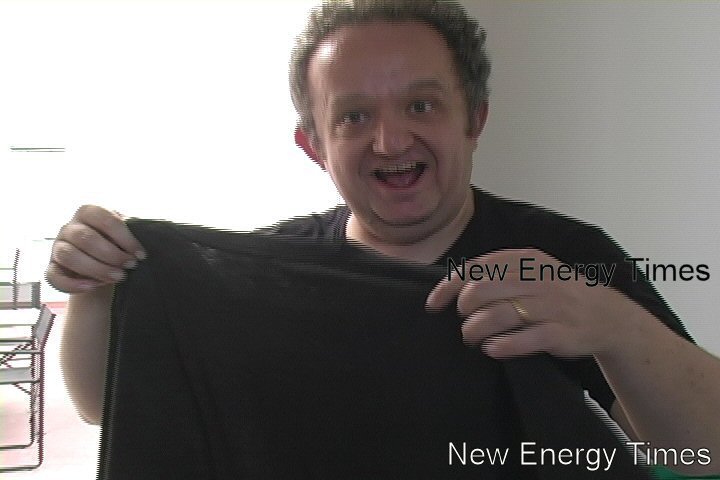
Levi Helps to Show Steam With His Black T-Shirt as Backdrop
(Photo: S.B. Krivit)

Ny Teknik Wrongly States That Rossi Experiment Was Performed at University of Bologna
Uppsala University Professor on Rossi Device: "You Have to Embrace This"
The article by Mats Lewan in Ny Teknik "Cold Fusion: 'You have to embrace this'” on Feb. 23, 2011, contains some remarkable statements from Essén and Kullander considering that they didn't even see the device until a month later on March 29. Lewan was the one who helped Rossi meet his next endorsers, Kullander and Essén.
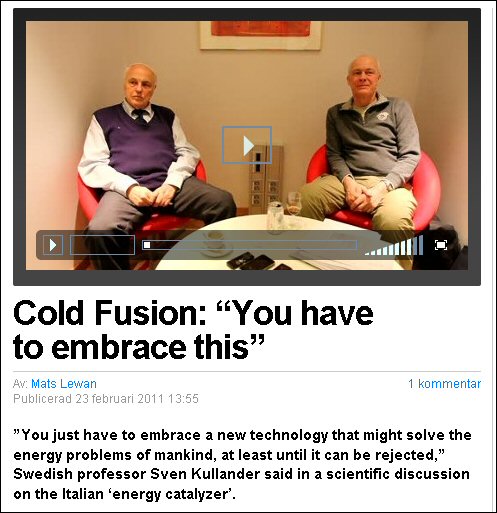
Sven Kullander (left) and Hanno Essén (right) in Video Interview With Mats Lewan
On Feb. 23, Essén and Kullander gave their public support to Rossi and his device before they had seen it. The Feb. 23 Ny Teknik provides some insight into their reasoning.
Essén based his support of Rossi's device on the following:
- His assumption that Levi was an independent researcher.
- His understanding that Rossi had already begun to sell devices and that they were commercially available.
Apparently, Essén did not go to great lengths to verify information that he received; however, he did maintain his objectivity and cautious skepticism at that time in the Ny Teknik interview.
"It’s very hard to guard against someone who is lying in this context," Essén said. "It’s almost impossible for us to know. You try to evaluate the physics, then you assume that the data is presented as honestly as possible."
Kullander put a lot of faith in Rossi and his claim.
”You just have to embrace a new technology that might solve the energy problems of mankind, at least until it can be rejected," Kullander said.
He based his support of Rossi's device on the following:
- He thought they used a "fairly scientific approach."
- "Above all, they have heated a building and have done so for one year, according to Rossi."
- He thought the device could not be properly assessed for an energy balance because the patent hadn't been granted.
- "In this case, you have to believe in the inventor Rossi, who says he has been producing heat without any input of energy except for what you have inside the device."
- He thought Rossi's device might be credible despite the lack of essential pieces of information "partly because he says it."
But there were some problems with the foundation of Essén’s opinions.
Levi was hardly independent. All of his tests were performed in Rossi's facility, in Rossi's presence, under Rossi's direction, on equipment designed, constructed and owned by Rossi and without any document that would provide Levi with sufficient details to perform an independent replication.
There were no Rossi devices sold, delivered or available. Rossi states his devices will go on sale in October. In an email, I asked Essén, "Where did you get the information that Rossi made many units and that they were already on sale?"
"I do not remember," Essén wrote, "but I think the Greek MW plant was already discussed at that time?”
I wrote to him that "the published facts, and I just confirmed with Mats Lewan, never said that there was a finished Rossi device or that the Rossi devices had been or were being sold."
I asked him to try to remember where he may have obtained his information or developed his perception. I did not receive a reply by the time we went to press.
There is another contradiction. Rossi has stated many times that he hasn't taken and won't be taking anybody's money until he delivers his 1 MW plant in October.
When I spoke with Essén on July 15, I mentioned to him that Capiluppi had told me that the Rossi research agreement would not become active until Rossi made the first payment to the university.
"According to what I heard," Essén sad, "the contract will become active in late October, because then Rossi will get money from Athens, but this is only speculation. According to the schedule I heard, nothing will happen until October."
On July 11, a Web site called E-Cat Report stated, according to Rossi, that an unsigned "co-operation agreement" was in place between Rossi and Uppsala University.

On July 12, I contacted Senior Press Officer Anneli Waara of Uppsala University in an attempt to confirm the story. Waara sent my inquiry to Kullander and Essén.
“According to Professor Kullander, there is no such agreement or preparing for an agreement as suggested by that information,” Waara wrote.
There were even greater problems with the foundation of Kullander's opinions as expressed in the Ny Teknik article.
The Rossi group's approach was far from "fairly scientific." The researchers did not run control experiments, did not measure heat output directly and did not consult with engineers qualified to evaluate either the quantity or the quality of the steam. The researchers also ignored or dismissed suggestions given to them by Celani and other people on how they could get an accurate energy balance and avoid the steam issues.
For example, many people have suggested to Rossi that one of the best ways to verify his claim is to start an experiment with 30 gallons of cold water and end up with 30 gallons of hot water by condensing the device's output into a second tank while monitoring the temperature change of the water. Rossi's refusal to perform such a simple and potentially unambiguous test significantly undermines the credibility of his claim.
Kullander thought that the most significant piece of information was that Rossi had heated a building for a year with one of his devices. No evidence exists to support this claim. Not even Rossi's patent application makes the claim. In it, Rossi uses a cleverly worded sentence (Appendix 28) to give the impression that he heated the building with his device. But that's not what the sentence says.
We have only Rossi's word that he had a practical, working device heating his building. For example, according to professor David J. Nagel of The George Washington University, Rossi said that one of his devices was "installed on October 16, 2007, was operating 24 hours per day, and provided an amount of energy sufficient to heat the factory of [Rossi's] Company, EON. There was a 90% savings on electricity bills over a period of six months."
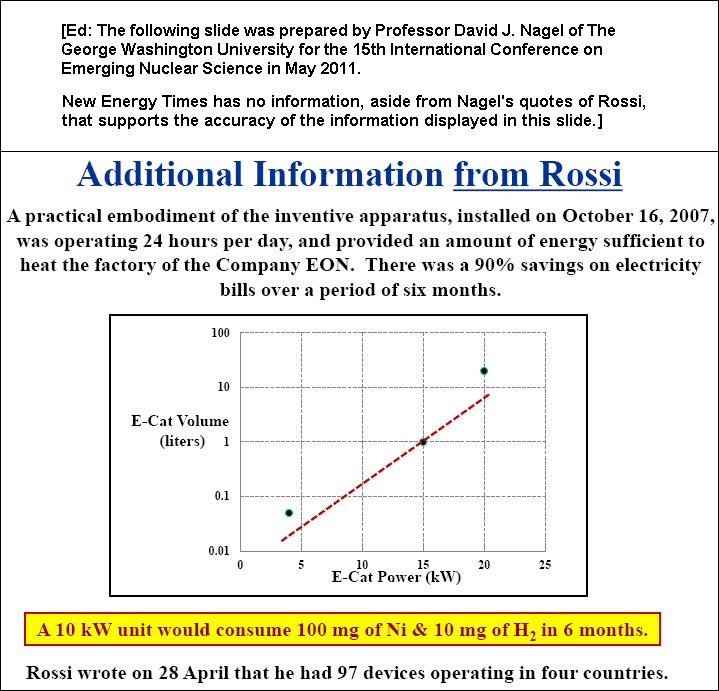
According to statements by Focardi, in a May 4, 2011, workshop at Pavia University, in Italy, he and Rossi had performed their first experiment in 2007, and it worked all night without external energy input. As reported by Query Online, Rossi and Focardi's "very first and rough prototype device was submerged in a water bucket laid on a barrel."
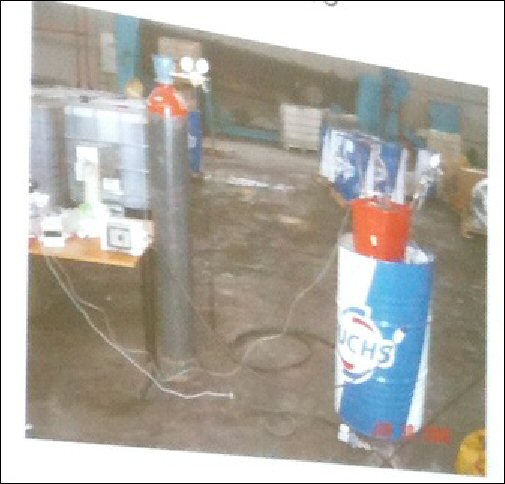
Photograph of Early Prototype of Rossi Device
(Photo Sources: Query and Focardi)
Another problem with Kullander's reasoning is that he thought that Rossi device could not be assessed properly for an energy balance because the patent hadn't been granted. This is incorrect. A black box can be tested without going inside it and risking the loss of proprietary information.
Last, Kullander mentioned twice in the news story that readers "have to believe in the inventor Rossi" and take his word "partly because he says it."
Search for Science
I went to Italy in search of the best facts that I thought Rossi, Focardi and Levi might have to support their claims. As my video interviews with the trio show, I asked about their steam measurements. I asked to see scientific evidence for their 18-hour sub-boiling test. I asked to see scientific evidence for their self-sustaining claim. Rossi had the opportunity to show me the volume and velocity of steam exiting directly from his device. Either he did not understand these facts, or he did not want me to see them. I asked to see the best evidence they had for isotopic anomalies. Rossi showed me vague graphs (Appendix 21). I came away virtually empty-handed. Do they have real science? Possibly. Are they mistaken? Possibly. Do they have a technology? I've seen no evidence of it.
For example, I asked Levi during my interview with him on June 14 about the data for the Jan. 14 test.
"In the second test, in the January test, data were lost," Levi said. "Also, I have written a report without having the real — because Rossi has switched off his computer," Levi said.
During the interview, I asked Levi about the best evidence he had for a self-sustaining effect. I asked whether he had any graphs that showed both input power and output temperature over time. Again, this is a basic set of data that a high school student would know to do.
"If you see the data acquisition [on the experiment], you have two systems," Levi said. "One was for power, the other one for temperature. Then you have to put this data together. And when you put data together from different data acquisition systems with different clocks, you must be sure that everything is correctly aligned."
However, a mechanical engineer who used data that was publicly available was able to do this for the Jan. 14, 2011 test, without much trouble, in spite of the fact that Rossi lost the data. (Appendix 17)
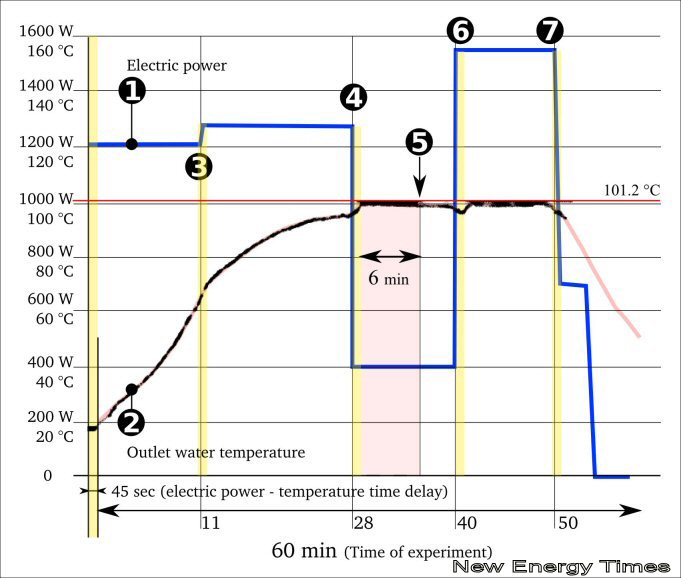
Mechanical Engineer's Analysis of Power and Temperature in Jan. 14, 2011, Rossi Experiment
Toward the end of my discussion with Levi about the Feb. 10-11, 2011, test, I asked Levi whether showing me the raw scientific data would be a problem for him.
"Not really,” he said. “But then people will start to make any kind of funny analysis on it, and then I will have to answer this funny analysis."
I reminded him that he gave numbers (claims) to the press but without any scientific data to support those numbers.
"If you don't want to trust these numbers, don't trust them! It's very simple," Levi said.
He explained that, to show proper evidence, he needs to set up a complete measurement apparatus, and that would take at least three months.
I asked, "What would you say is the value of the numbers that you reported to Mats Lewan [Ny Teknik]? Is there any credibility to those numbers?”
"There is no credibility as scientific paper credibility,” Levi said. “If you trust me, this is what I have seen with my best effort. Also, I was really conservative."
Hope for Technology
Do they have any competitors in the arena of Ni-H gas LENR, or even in the field of LENR? Scientifically, yes, lots of good competitors. Technologically? No. From a business and entrepreneurial perspective, this, as well as all other known attempts at practical LENR devices, seem to be missing fundamental scientific understanding; theoretical as well as experimental. If entrepreneurs do not understand the science, their attempts to commercialize a technology likely will fail and cause disappointment.
The only person with a competing patent application is Francesco Piantelli. I've not heard much from Piantelli on recent scientific progress, and I have heard no news from him of any technological progress. I have not seen Piantelli for a few years, but I have been in touch with him recently to confirm the history of his research.
As far as I know, Piantelli was the first to start working on the idea of Ni-H gas LENR, and he and Focardi agree on this. Piantelli began his work alone, presented his initial findings at a conference, then later began working with Focardi and Roberto Habel from Cagliari University and the National Institute of Nuclear Physics-Cagliari.
Here is Piantelli's account:
"The meeting with Roberto and Focardi took place in October 1990 at the National Conference (October 8-13, 1990) of the Italian Physics Society in Trento. I went to the meeting in order to find someone who wanted to take a look at the experimental results I obtained starting from January 1990. Among the people I met in that congress were Habel and Focardi. I presented to them my experimental data. Those data were later presented in a scientific meeting of Accademia dei Fisiocritici in Siena and published in the Atti of the Academy in 1993.
I presented also my opinion concerning the phenomenon. I thought that it wasn't cold fusion because it is impossible to overcome the potential barrier, even though I had read the superradiance and coherence theory of Giuliano Preparata. Habel and Focardi, and other people who I discussed my results with, were very skeptical of my results. Only after I reproduced the experiments a few times was I able to start a real collaboration with them. This resulted in our paper in 1994 in Il Nuovo Cimento and other publications that followed."
In the last year, I have asked Piantelli how people can best learn about his experiment and attempt to repeat it. He has told me that his two patent applications are the best resources. If I recall, one of them provides some details for a catalyst. Here are the links, as well as some links to my two previous articles on Piantelli:
Piantelli WIPO/PCT Application 95/20816 (Source)
Piantelli European Patent granted #EP0767962 (Patent Granted June 2, 1999. Now expired, renewal fees unpaid) (Other National Phase)
Deuterium and Palladium Not Required
Piantelli-Focardi Publication and Replication Path (See reference section for scientific bibliography and key technical papers.)
On Page 2 of the Piantelli group’s 1998 paper, "Large Excess Heat Production in Ni-H Systems," (Il Nuovo Cimento, Vol. 111A, p. 1233-1242, (1998)), the paper mentions a special surface coating that contains nickel ammonium sulphate, citric acid, ammonium hydroxide and sodium disulfite.
Journalist Maurizio Torrealta of RAI -TV asked Rossi on a show broadcast on May 3, 2011, how he came up with the idea of the secret additive.
"10% intuition and 90% perspiration," Rossi said. "I tried thousands of reactors and thousands of different combinations until I arrived at the one that worked."
A Hoax?
Rossi has claimed, many times and in many reports, that he is not asking anybody for money until he delivers a working product for sale. For example, he said so on March 18 in Ny Teknik.
"I want no money from anybody until the plants have started up to demonstrate they maintain the guarantees. I want all the risks on me. This of course makes the beginning slow, but I want not to put on risk the money which is not mine."
Rossi's Greek licensee, Defkalion Green Technologies, however, is asking for money and asking investors to bear the risk. For 40.4 million Euros, one company per country can have the exclusive rights to manufacture and sell Rossi's device, according to a July 6 letter from Symeon Tsalikoglou, the director of business development and marketing for Defkalion.
Few people have seen as many new, strange and innovative ideas as Tony Tether has. Tether is the president of the Sequoia Group, a consulting firm, and he served as director of the Defense Advanced Research Projects Agency from June 18, 2001, until February 20, 2009.
As he told me, he, too, met Rossi and saw one of his demonstrations, last year in New Hampshire.
"It wasn't one of his best experiments, according to Rossi, but it went on for a long time," Tether said. "The weight of the hydrogen bottle was being measured, and it wasn't decreasing. The input power was being measured, and it was what he said it was.
"I did have a chance to talk to him, and he was evasive when I directly asked him what was going on. He complained why we needed to take separate measurements. I told him that, if he didn't want to disclose how it worked, then there was no other choice but to make sure there wasn't a person behind the curtain. (I don't think he understood my Wizard of Oz reference.)
"If it is a hoax, it is a damn good one."
Rossi Goes to NASA
On July 14, Rossi met with members of NASA's Marshall Space Flight Center in Huntsville, Alabama.
The next day, I spoke with the man who organized the meeting, Michael A. Nelson. Nelson is a systems engineer and has been at NASA for 30 years. He has experience in a wide variety of engineering disciplines.
He has worked at NASA in the main propulsion group for the space shuttle as well as with the launch monitoring systems. July 15 was a historic day for Nelson and many other NASA staff members because it was the final day of the last space shuttle mission.
Nelson explained to me that his facility has excellent resources for testing anomalous claims and that it has always been open and interested in new ideas.
Nelson would not go into detail on the record with me about the meeting with Rossi, but he did provide a few facts.
- Rossi had contacted Nelson several months ago, asking to visit.
- Rossi paid his own expenses to attend the July 14 meeting at Marshall.
- Approximately 25 people comprising NASA staff and outside contractors attended the meeting.
- There was no demonstration, only a discussion about Rossi's device.
- NASA showed my June 14 video, in which Rossi demonstrated his device to me.
- NASA is offering an opportunity to test Rossi's device so long as there is no cost to the government.
- No agreement has been established.
- NASA 's interest is for possible space applications of the device.
- Further details are not available at this time.
Nelson was eager to see the truth about Rossi's device revealed, however it turns out.
"Hope is good as long as it’s not false hope," Nelson wrote. "False hope is one of the most destructive kinds of forces in the LENR field. The truth is what gets us through any of this."
Nelson explained that he was trying to open avenues for new research at NASA, including LENR research.
"LENR is another avenue. It's not just about Rossi," Nelson said, "If the Rossi thing doesn't happen, then maybe something else will.
"Rossi has brought a lot of attention to the field. Any researchers who have a legitimate claim are going to benefit from this."
[Ed: Correction (Aug. 1, 2011) The statement about "the force of 11,200 liters of steam per hour exiting from it would cause it to jump around wildly like a snake" is not supported by the physics and has been removed.]
[Ed: Clarification (Aug. 3, 2011) In Ekström's analysis, he had estimated the hose inner diameter at 20 mm. Based on other analyses we have received, we have used the value of 12 mm here instead.]
⇐ Previous Article — Table of Contents — Next Article ⇒
|


